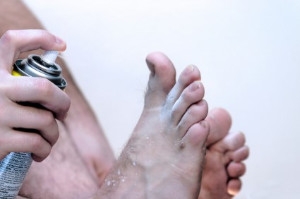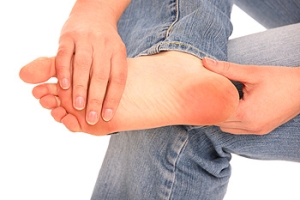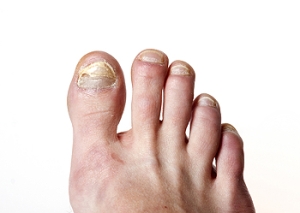Merrillville, IN
Munster, IN

Treating Athlete’s Foot
 A common fungal skin infection is known as athlete’s foot. Athlete’s foot is contagious, and can be spread by not wearing the proper footwear in places where fungus thrives, such as swimming pools and communal showers. Scaly, itchy rashes between the toes are often a key indicator that you have developed this uncomfortable condition. To help relieve this discomfort, over the counter powders, sprays, ointments, and lotions may be beneficial for your case. Using hydrogen peroxide can also be useful in killing the fungus on the surface of the skin. Making sure your feet are clean and dry is another great first step in preventing the infection from worsening. For a proper diagnosis and advice on which treatment may be best for you, please speak with a podiatrist.
A common fungal skin infection is known as athlete’s foot. Athlete’s foot is contagious, and can be spread by not wearing the proper footwear in places where fungus thrives, such as swimming pools and communal showers. Scaly, itchy rashes between the toes are often a key indicator that you have developed this uncomfortable condition. To help relieve this discomfort, over the counter powders, sprays, ointments, and lotions may be beneficial for your case. Using hydrogen peroxide can also be useful in killing the fungus on the surface of the skin. Making sure your feet are clean and dry is another great first step in preventing the infection from worsening. For a proper diagnosis and advice on which treatment may be best for you, please speak with a podiatrist.
Athlete’s foot is an inconvenient condition that can be easily reduced with the proper treatment. If you have any concerns about your feet and ankles, contact Ahmad Elsamad, DPM from The Institute of Foot & Ankle Reconstructive Surgery . Our doctor will treat your foot and ankle needs.
Athlete’s Foot: The Sole Story
Athlete's foot, also known as tinea pedis, can be an extremely contagious foot infection. It is commonly contracted in public changing areas and bathrooms, dormitory style living quarters, around locker rooms and public swimming pools, or anywhere your feet often come into contact with other people.
Solutions to Combat Athlete’s Foot
- Hydrate your feet by using lotion
- Exfoliate
- Buff off nails
- Use of anti-fungal products
- Examine your feet and visit your doctor if any suspicious blisters or cuts develop
Athlete’s foot can cause many irritating symptoms such as dry and flaking skin, itching, and redness. Some more severe symptoms can include bleeding and cracked skin, intense itching and burning, and even pain when walking. In the worst cases, Athlete’s foot can cause blistering as well. Speak to your podiatrist for a better understanding of the different causes of Athlete’s foot, as well as help in determining which treatment options are best for you.
If you have any questions please feel free to contact our offices located in Merrillville, and Munster, IN . We offer the newest diagnostic and treatment technologies for all your foot and ankle needs.
Athlete's Foot
Athlete’s foot is an extremely contagious infection caused by a fungus that results in itching, burning, dry, and flaking feet. The fungus that causes athlete’s foot is known as tinea pedis and thrives in moist, dark areas such as shower floors, gyms, socks and shoes, commons areas, public changing areas, bathrooms, dormitory style houses, locker rooms, and public swimming pools. Athlete’s foot is difficult to treat as well because of the highly contagious and recurrent nature of the fungus.
Tinea is the same fungus that causes ringworm, and is spread by direct contact with an infected body part, contaminated clothing, or by touching other objects and body parts that have been exposed to the fungus. Because the feet are an ideal place for tinea to grow and spread, this is the most commonly affected area. It is, however, known to grow in other places. The term athlete’s foot describes tinea that grows strictly on the feet.
The most commonly infected body parts are the hands, groin, and scalp, as well as the feet. Around 70% of the population suffer from tinea infections at some point in their lives, however not all of these cases are athlete’s foot. Just like any other ailment, some people are more likely to get it than others, such as people with a history of tinea infections or other skin infections, both recurring and non-recurring ones. The extent to which a person experiences regrowth and recurrent tinea infections varies from person to person.
Sometimes people will not even know that they are infected with tinea or that they have athlete’s foot because of a lack of symptoms. However, most experience mild to moderate flaking, itching, redness, and burning. However, some of the more severe symptoms include cracking and bleeding skin, intense itching and burning, pain while walking or standing, and even blistering.
Because of the recurring nature of the tinea fungus and the athlete’s foot it causes, the best way to treat this condition is with prevention. You can take some preventative measures such as wearing flip flops or sandals in locker rooms and public showers to reduce contact with the floor. It also helps to keep clean, dry feet while allowing them to breathe. Using powders to keep your feet dry is a good idea, as well as keeping your feet exposed to light and cool air, to prevent the growth of tinea. If you do happen to get athlete’s foot, opt for using topical medicated creams, ointments or sprays. These treatments help eliminate and prevent it from coming back.
Common Risk Factors of Cuboid Syndrome
 When the joints or ligaments surrounding the cuboid bone in your foot are injured or torn, it’s possible you may develop cuboid syndrome. Certain forms of arthritis may increase your chances of getting cuboid syndrome, such as osteoarthritis and gout. Common risk factors for this condition may include obesity, wearing footwear that is too tight or lacks support, not stretching before working out, partaking in physical activity on uneven surfaces, and a lack of rest between physical activities. Pain on the lateral side of your foot is a common indicator of cuboid syndrome, along with tenderness and redness towards that area. If you believe you have developed cuboid syndrome, please consult with a podiatrist for advice on treatment options.
When the joints or ligaments surrounding the cuboid bone in your foot are injured or torn, it’s possible you may develop cuboid syndrome. Certain forms of arthritis may increase your chances of getting cuboid syndrome, such as osteoarthritis and gout. Common risk factors for this condition may include obesity, wearing footwear that is too tight or lacks support, not stretching before working out, partaking in physical activity on uneven surfaces, and a lack of rest between physical activities. Pain on the lateral side of your foot is a common indicator of cuboid syndrome, along with tenderness and redness towards that area. If you believe you have developed cuboid syndrome, please consult with a podiatrist for advice on treatment options.
Cuboid syndrome, also known as cuboid subluxation, occurs when the joints and ligaments near the cuboid bone in the foot become torn. If you have cuboid syndrome, consult with Ahmad Elsamad, DPM from The Institute of Foot & Ankle Reconstructive Surgery . Our doctor will assess your condition and provide you with quality foot and ankle treatment.
Cuboid syndrome is a common cause of lateral foot pain, which is pain on the outside of the foot. The condition may happen suddenly due to an ankle sprain, or it may develop slowly overtime from repetitive tension through the bone and surrounding structures.
Causes
The most common causes of cuboid syndrome include:
- Injury – The most common cause of this ailment is an ankle sprain.
- Repetitive Strain – Tension placed through the peroneus longus muscle from repetitive activities such as jumping and running may cause excessive traction on the bone causing it to sublux.
- Altered Foot Biomechanics – Most people suffering from cuboid subluxation have flat feet.
Symptoms
A common symptom of cuboid syndrome is pain along the outside of the foot which can be felt in the ankle and toes. This pain may create walking difficulties and may cause those with the condition to walk with a limp.
Diagnosis
Diagnosis of cuboid syndrome is often difficult, and it is often misdiagnosed. X-rays, MRIs and CT scans often fail to properly show the cuboid subluxation. Although there isn’t a specific test used to diagnose cuboid syndrome, your podiatrist will usually check if pain is felt while pressing firmly on the cuboid bone of your foot.
Treatment
Just as the range of causes varies widely, so do treatments. Some more common treatments are ice therapy, rest, exercise, taping, and orthotics.
If you have any questions, please feel free to contact our offices located in Merrillville, and Munster, IN . We offer the newest diagnostic and treatment technologies for all your foot care needs.
Cuboid Syndrome
Cuboid syndrome mostly affects athletes, although it can affect non-athletes too. It is also known as cuboid subluxation or cuboid fault syndrome. This condition occurs when joints and ligaments near the cuboid bone of the foot are damaged, or when the cuboid bone itself is dislodged from its natural position. It is usually marked by pain on the outer side of the foot, which may be persistent or may come and go. Cuboid syndrome can be difficult to diagnose unless it becomes severe and more noticeable. Your doctor will likely ask questions about when the pain began and how long it has been present, and will put pressure on the cuboid bone to determine if that area is the origin of the pain.
Causes of Cuboid Syndrome
- Any repetitive stresses placed on the foot due to athletic activities are a common cause of cuboid syndrome.
- Although it develops over time, it is possible that this syndrome can occur all of sudden due to a single event or injury.
- Over-pronation can exacerbate the condition if not corrected.
Disagreements Amongst Podiatrists Regarding Cuboid Syndrome
- Some refer to it as the dislocation of the calcaneal-cuboid joint only.
- Other podiatrists see it as an injury of the ligaments located nearby, which also involves the cuboid bone.
It is very important that when you experience any kind of pain on the side of your foot, you should seek medical care right away. If a subluxed cuboid is caught early, your feet may respond well to the treatment, and you can get back into sports or other activities again as soon as the pain subsides.
What are the Symptoms of Toenail Fungus?
 Toenail fungus is a contagious fungal infection, and can spread from wearing an infected person’s shoes or socks, and possibly from sharing towels. Toenail fungus lives and thrives in warm and moist environments, such as public swimming pools, locker rooms, and surrounding areas. Common symptoms that are often associated with toenail fungus can include the affected nail becoming yellow, thick, and brittle. In severe cases, the nail may lift off of the nail bed, and a new nail will gradually grow underneath it. If you see the beginning stages of toenail fungus, please speak to a podiatrist as quickly as possible so that the proper treatment can begin.
Toenail fungus is a contagious fungal infection, and can spread from wearing an infected person’s shoes or socks, and possibly from sharing towels. Toenail fungus lives and thrives in warm and moist environments, such as public swimming pools, locker rooms, and surrounding areas. Common symptoms that are often associated with toenail fungus can include the affected nail becoming yellow, thick, and brittle. In severe cases, the nail may lift off of the nail bed, and a new nail will gradually grow underneath it. If you see the beginning stages of toenail fungus, please speak to a podiatrist as quickly as possible so that the proper treatment can begin.
For more information about treatment, contact Ahmad Elsamad, DPM of The Institute of Foot & Ankle Reconstructive Surgery . Our doctor can provide the care you need to keep you pain-free and on your feet.
Toenail Fungus Treatment
Toenail fungus is a condition that affects many people and can be especially hard to get rid of. Fortunately, there are several methods to go about treating and avoiding it.
Antifungals & Deterrence
Oral antifungal medicine has been shown to be effective in many cases. It is important to consult with a podiatrist to determine the proper regiment for you, or potentially explore other options.
Applying foot powder on the feet and shoes helps keep the feet free of moisture and sweat.
Sandals or open toed shoes – Wearing these will allow air movement and help keep feet dry. They also expose your feet to light, which fungus cannot tolerate. Socks with moisture wicking material also help as well.
If you have any questions please feel free to contact our offices located in Merrillville, and Munster, IN . We offer the newest diagnostic tools and technology to treat your foot and ankle needs.
How to Treat Your Toenail Fungus
While not a serious issue, toenail fungus, or onychomycosis, can be an embarrassing and uncomfortable condition to experience. Toenail fungus is often caused from public areas that harbor fungi and improper cleaning/drying of the foot. Once infected, the fungus grows deeper into the nail and can be very hard to get rid of.
There are different types of fungus that cause toenail fungus. Dermatophytes, yeasts, and molds are the most frequent forms of fungus to infect the toenail. Dermatophytes are the most common among the three. Symptoms associated with fungal nails include the discoloration of the toenail, brittleness, and in some circumstances, a smell. Pain is rarely a symptom caused by toenail fungus.
Diagnosis of fungal nails is generally a rather quick process. However podiatrists will make sure that the cause is not another condition such as lichen planus, psoriasis, onychogryphosis, or nail damage. Podiatrists will make use of fungal cultures and microscopy to verify that it is fungus.
While over-the-counter ointments are readily available, most are ineffective. This is due to the fact that the nail is very protective and that the fungus slips in between the nail plate and bed. Podiatrists can offer oral medication which currently provides the best results.
Ultimately, prevention is the best line of defense against toenail fungus. Avoid unsanitary public showers. If you do use a public shower, use shower shoes to provide your foot with protection. Once you are finished showering, make sure to thoroughly dry your feet. Fungi thrive in warm, dark, and moist places like sweaty, warm feet that are left dark in shoes all day.
What to Expect If a Bunion Develops on Your Toe
 Have you noticed a bump appear on the side of your big toe? If so, you may have developed a bunion. Bunions can be common among older women, however, they can affect anyone. Those affected by a bunion may experience pain, swelling, difficulty walking, a callus on or around the bunion, and a misshapen toe that leans inward, caused by the bunion. Symptoms generally worsen over time if left untreated, which is why it’s important to seek immediate care. If you believe you are experiencing symptoms of a bunion, please consult with a podiatrist for a proper diagnosis and advised treatment plan.
Have you noticed a bump appear on the side of your big toe? If so, you may have developed a bunion. Bunions can be common among older women, however, they can affect anyone. Those affected by a bunion may experience pain, swelling, difficulty walking, a callus on or around the bunion, and a misshapen toe that leans inward, caused by the bunion. Symptoms generally worsen over time if left untreated, which is why it’s important to seek immediate care. If you believe you are experiencing symptoms of a bunion, please consult with a podiatrist for a proper diagnosis and advised treatment plan.
If you are suffering from bunions, contact Ahmad Elsamad, DPM of The Institute of Foot & Ankle Reconstructive Surgery . Our doctor can provide the care you need to keep you pain-free and on your feet.
What Is a Bunion?
A bunion is formed of swollen tissue or an enlargement of boney growth, usually located at the base joint of the toe that connects to the foot. The swelling occurs due to the bones in the big toe shifting inward, which impacts the other toes of the foot. This causes the area around the base of the big toe to become inflamed and painful.
Why Do Bunions Form?
Genetics – Susceptibility to bunions are often hereditary
Stress on the feet – Poorly fitted and uncomfortable footwear that places stress on feet, such as heels, can worsen existing bunions
How Are Bunions Diagnosed?
Doctors often perform two tests – blood tests and x-rays – when trying to diagnose bunions, especially in the early stages of development. Blood tests help determine if the foot pain is being caused by something else, such as arthritis, while x-rays provide a clear picture of your bone structure to your doctor.
How Are Bunions Treated?
- Refrain from wearing heels or similar shoes that cause discomfort
- Select wider shoes that can provide more comfort and reduce pain
- Anti-inflammatory and pain management drugs
- Orthotics or foot inserts
- Surgery
If you have any questions, please feel free to contact our offices located in Merrillville, and Munster, IN . We offer the newest diagnostic and treatment technologies for all your foot care needs.
What Are Bunions?
Bunions are large bony bumps at the base of the big toe. Medically known as hallux valgus, a bunion is a misalignment of the metatarsophalangeal joint, or big toe joint. The misalignment will generally worsen with time if left untreated.
The exact cause of bunions is unknown, with genetics seen as a potential cause. High heels and poorly-fitted footwear, rheumatoid arthritis, and heredity all seem to be potential factors behind the exacerbation of bunions. Women have been found to be more likely to develop bunions in comparison to men.
Bunions do not always produce symptoms. The best way to tell is if the big toe is pushing up against the next toe and there is a large protrusion at the base of the big toe. You may or may not feel pain. Redness, swelling, and restricted movement of the big toe may be present as well.
Podiatrists use a variety of methods to diagnose bunions. If there are symptoms present, podiatrists will first consider that it is a bunion. If not, a physical examination will be conducted to check function of the big toe. Finally, an X-ray may be taken to view the extent of the bunion and confirm it is a bunion.
Typically, nonsurgical methods are used to treat bunions, unless the bunion has become too misaligned. Orthotics, icing and resting the foot, roomier and better fitted shoes, taping the foot, and pain medication are usually utilized first. If the bunion doesn’t go away or causes extreme pain, surgery may be required. Surgeons will either remove part of the swollen tissue or bone to straighten the toe out.
If you have a bunion, it is recommended to see a podiatrist. The longer it is left untreated, the worse it may get. Podiatrists can properly diagnose and treat a bunion before it gets worse.
Reasons for Reconstructive Foot Surgery
 Foot reconstruction is a type of surgery that is performed to correct the anatomy of the foot and restore proper function. Someone might need reconstructive foot surgery following a major injury to the foot that affects the foot’s soft tissue or bones. Vascular diseases, which can interfere with circulation in the lower limbs, may require surgical intervention. Other issues which can cause deformities include metabolic diseases, such as diabetes and gout, that alter the blood and nerve supply of the foot, and tumors. Finally, birth defects such as clubfoot would also need to be corrected via reconstructive surgery. For more information on reconstructive foot surgery, please consult with a podiatrist.
Foot reconstruction is a type of surgery that is performed to correct the anatomy of the foot and restore proper function. Someone might need reconstructive foot surgery following a major injury to the foot that affects the foot’s soft tissue or bones. Vascular diseases, which can interfere with circulation in the lower limbs, may require surgical intervention. Other issues which can cause deformities include metabolic diseases, such as diabetes and gout, that alter the blood and nerve supply of the foot, and tumors. Finally, birth defects such as clubfoot would also need to be corrected via reconstructive surgery. For more information on reconstructive foot surgery, please consult with a podiatrist.
Foot surgery is sometimes necessary to treat a foot ailment. To learn more, contact Ahmad Elsamad, DPM of The Institute of Foot & Ankle Reconstructive Surgery . Our doctor will assist you with all of your foot and ankle needs.
When Is Surgery Necessary?
Foot and ankle surgery is generally reserved for cases in which less invasive, conservative procedures have failed to alleviate the problem. Some of the cases in which surgery may be necessary include:
- Removing foot deformities like bunions and bone spurs
- Severe arthritis that has caused bone issues
- Cosmetic reconstruction
What Types of Surgery Are There?
The type of surgery you receive will depend on the nature of the problem you have. Some of the possible surgeries include:
- Bunionectomy for painful bunions
- Surgical fusion for realignment of bones
- Neuropathy decompression surgery to treat nerve damage
Benefits of Surgery
Although surgery is usually a last resort, it can provide more complete pain relief compared to non-surgical methods and may allow you to finally resume full activity.
Surgical techniques have also become increasingly sophisticated. Techniques like endoscopic surgery allow for smaller incisions and faster recovery times.
If you have any questions please feel free to contact our offices located in Merrillville, and Munster, IN . We offer the newest diagnostic and treatment technologies for all your foot and ankle needs.














